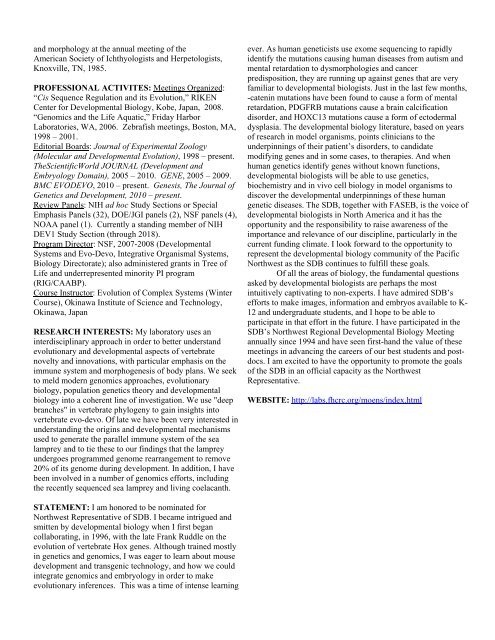Call for Nominations for 2013 SDB Elections - Society for ...
Call for Nominations for 2013 SDB Elections - Society for ...
Call for Nominations for 2013 SDB Elections - Society for ...
Create successful ePaper yourself
Turn your PDF publications into a flip-book with our unique Google optimized e-Paper software.
and morphology at the annual meeting of the<br />
American <strong>Society</strong> of Ichthyologists and Herpetologists,<br />
Knoxville, TN, 1985.<br />
PROFESSIONAL ACTIVITES: Meetings Organized:<br />
“Cis Sequence Regulation and its Evolution,” RIKEN<br />
Center <strong>for</strong> Developmental Biology, Kobe, Japan, 2008.<br />
“Genomics and the Life Aquatic,” Friday Harbor<br />
Laboratories, WA, 2006. Zebrafish meetings, Boston, MA,<br />
1998 – 2001.<br />
Editorial Boards: Journal of Experimental Zoology<br />
(Molecular and Developmental Evolution), 1998 – present.<br />
TheScientificWorld JOURNAL (Development and<br />
Embryology Domain), 2005 – 2010. GENE, 2005 – 2009.<br />
BMC EVODEVO, 2010 – present. Genesis, The Journal of<br />
Genetics and Development, 2010 – present.<br />
Review Panels: NIH ad hoc Study Sections or Special<br />
Emphasis Panels (32), DOE/JGI panels (2), NSF panels (4),<br />
NOAA panel (1). Currently a standing member of NIH<br />
DEV1 Study Section (through 2018).<br />
Program Director: NSF, 2007-2008 (Developmental<br />
Systems and Evo-Devo, Integrative Organismal Systems,<br />
Biology Directorate); also administered grants in Tree of<br />
Life and underrepresented minority PI program<br />
(RIG/CAABP).<br />
Course Instructor: Evolution of Complex Systems (Winter<br />
Course), Okinawa Institute of Science and Technology,<br />
Okinawa, Japan<br />
RESEARCH INTERESTS: My laboratory uses an<br />
interdisciplinary approach in order to better understand<br />
evolutionary and developmental aspects of vertebrate<br />
novelty and innovations, with particular emphasis on the<br />
immune system and morphogenesis of body plans. We seek<br />
to meld modern genomics approaches, evolutionary<br />
biology, population genetics theory and developmental<br />
biology into a coherent line of investigation. We use "deep<br />
branches" in vertebrate phylogeny to gain insights into<br />
vertebrate evo-devo. Of late we have been very interested in<br />
understanding the origins and developmental mechanisms<br />
used to generate the parallel immune system of the sea<br />
lamprey and to tie these to our findings that the lamprey<br />
undergoes programmed genome rearrangement to remove<br />
20% of its genome during development. In addition, I have<br />
been involved in a number of genomics ef<strong>for</strong>ts, including<br />
the recently sequenced sea lamprey and living coelacanth.<br />
ever. As human geneticists use exome sequencing to rapidly<br />
identify the mutations causing human diseases from autism and<br />
mental retardation to dysmorphologies and cancer<br />
predisposition, they are running up against genes that are very<br />
familiar to developmental biologists. Just in the last few months,<br />
-catenin mutations have been found to cause a <strong>for</strong>m of mental<br />
retardation, PDGFRB mutations cause a brain calcification<br />
disorder, and HOXC13 mutations cause a <strong>for</strong>m of ectodermal<br />
dysplasia. The developmental biology literature, based on years<br />
of research in model organisms, points clinicians to the<br />
underpinnings of their patient’s disorders, to candidate<br />
modifying genes and in some cases, to therapies. And when<br />
human genetics identify genes without known functions,<br />
developmental biologists will be able to use genetics,<br />
biochemistry and in vivo cell biology in model organisms to<br />
discover the developmental underpinnings of these human<br />
genetic diseases. The <strong>SDB</strong>, together with FASEB, is the voice of<br />
developmental biologists in North America and it has the<br />
opportunity and the responsibility to raise awareness of the<br />
importance and relevance of our discipline, particularly in the<br />
current funding climate. I look <strong>for</strong>ward to the opportunity to<br />
represent the developmental biology community of the Pacific<br />
Northwest as the <strong>SDB</strong> continues to fulfill these goals.<br />
Of all the areas of biology, the fundamental questions<br />
asked by developmental biologists are perhaps the most<br />
intuitively captivating to non-experts. I have admired <strong>SDB</strong>’s<br />
ef<strong>for</strong>ts to make images, in<strong>for</strong>mation and embryos available to K-<br />
12 and undergraduate students, and I hope to be able to<br />
participate in that ef<strong>for</strong>t in the future. I have participated in the<br />
<strong>SDB</strong>’s Northwest Regional Developmental Biology Meeting<br />
annually since 1994 and have seen first-hand the value of these<br />
meetings in advancing the careers of our best students and postdocs.<br />
I am excited to have the opportunity to promote the goals<br />
of the <strong>SDB</strong> in an official capacity as the Northwest<br />
Representative.<br />
WEBSITE: http://labs.fhcrc.org/moens/index.html<br />
STATEMENT: I am honored to be nominated <strong>for</strong><br />
Northwest Representative of <strong>SDB</strong>. I became intrigued and<br />
smitten by developmental biology when I first began<br />
collaborating, in 1996, with the late Frank Ruddle on the<br />
evolution of vertebrate Hox genes. Although trained mostly<br />
in genetics and genomics, I was eager to learn about mouse<br />
development and transgenic technology, and how we could<br />
integrate genomics and embryology in order to make<br />
evolutionary inferences. This was a time of intense learning















